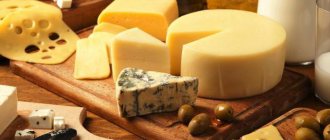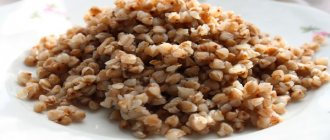Tilsiter is a semi-hard cheese of a light yellow hue with a texture characterized by small “eyes” and cracks. A very common so-called table cheese, the use of which in culinary art is practically unlimited. Tilsiter is added to salads, hot dishes, sauces are made from it and, of course, sandwiches are prepared with it. The first to produce it, using ancient peasant recipes, were Prussian-Swiss settlers in the city of Tilsit (now Sovetsk, Kaliningrad region). At the end of the 19th century, it appeared on production lines in Switzerland, thanks to recipes exported from Tilsit. Today there are three main varieties, conventionally designated Green, Yellow and Red label. The first is prepared from pasteurized milk, the second from pasteurized milk with cream, the third from unpasteurized milk.
How to make Tilsiter cheese at home?
You can prepare Tilsiter at home, with your own hands, however, this will require some special equipment: a 1 kilogram cheese mold, a milk thermometer for instant temperature measurement, and a large saucepan with a capacity of more than 10 liters. In addition, you will have to find ingredients such as mesophilic starter culture, calcium chloride and rennet. However, you shouldn’t be scared; all these components can be quickly found and ordered in one of the many online stores for amateur cheese makers.
So, the recipe for Tilsiter cheese at home is as follows:
- Pour milk (10 liters) into a large saucepan, heat to 74 degrees (control with a thermometer), cool.
- Pour the starter (1/4 teaspoon) into warm water (100 ml), leave for 30 minutes.
- Heat the milk again, now to 37 degrees, pour the water with the starter into it, cover the pan with a lid and wait another half hour.
- Add rennet (1/2 teaspoon) to water (50 ml) at room temperature and immediately pour into the milk in a thin stream, stirring constantly.
- Now wait until a clot forms - it will take about an hour until this happens.
- Cut the resulting clot into 2-centimeter cubes with a long knife, and after 10-15 minutes, drain the resulting whey - about a glass.
- Place the pan on the fire and cook for about 10 minutes, constantly stirring gently and maintaining the temperature at 36-38 degrees. If the temperature rises, turn off the heat.
- Now remove about 30% of the resulting whey - you should get about 3 liters.
- Add clean boiled water to the pan, approximately 40% of the volume of product remaining in the pan.
- Heat the mass again to 36-38 degrees and, maintaining the temperature and stirring, cook the cheese for 10-15 minutes.
- Line the pan with a towel. Place the resulting “grains” of cheese into a mold, wrap it up and leave for half an hour.
- Turn over and wait another 10 minutes
- Place a 1kg press on the cheese, after 3 hours change it to a 3kg press.
- Prepare the brine - dissolve salt (200 grams) in boiled water (1 liter), strain it through cheesecloth, remove the compressed cheese and place in the brine.
- After 12 hours, remove the Tilsiter and leave it to dry at room temperature for two days, turning it over several times a day.
- The longest process left for preparing Tilsiter at home is aging, which takes from 30 to 90 days. The cheese needs to be kept at a temperature of 10-12 degrees, periodically it needs to be washed with running water and cleaned with a brush.
The shelf life of homemade Tilsiter cheese is one year at a storage temperature of 8-12 degrees.
- See also the features of making Grana Padano cheese
Application
Teltizer is used in the preparation of salads, side dishes, appetizers, hot sandwiches, pizza, baked goods and as a filling for omelets, pies, and pancakes. Especially tasty and aromatic baked goods with the addition of Teltizer and fresh vegetables. For example, a cheese pie in the oven. For the filling you need: 100 gr. — Teltizer, Roquefort, Gouda cheese, tomatoes, bell pepper. Ready-made puff pastry is suitable for the base. To prevent the pie from being dry, you need to add an egg, sour cream and garlic. Distribute the dough into the mold, grease with sour cream or tomato sauce, lay out the chopped vegetables and bake for 20 minutes in the oven at 160 degrees. Meanwhile, prepare the garlic sauce: beat the egg, sour cream and add garlic. After baking, the dish is filled with sauce and sprinkled with cheese.
Market Analytics
- COVID-19 is changing the rules of the game in the cosmetics market
- Beauty of the future: cosmetic innovations 2020
- New ingredients are the driving force of the cosmetics industry
Convenient search for beauty salons on our website
Beauty salons in Moscow Beauty salons in St. Petersburg Beauty salons in Ekaterinburg Beauty salons in Novosibirsk
Latest blog posts on our website
- Naturecream / Geranium (Pelargonium) oil for skin health and beauty
- Prostye-sovety / Save on a beauty salon: procedures that can be done at home
- Naturecream / Growth Factor - brings back youth?
- Oksana-Lezina / 3 effective abdominal exercises from a fitness instructor for beginners
- Prostye-sovety / Making perfect curls at home
- Prostye-sovety / Which hair removal method to choose
- Naturecream / Wrinkles Puppets
- Naturecream / PEPHA-TIGHT - instant skin lifting
- Naturecream / Blue light - a danger to the skin
- Naturecream / Cocoa Butter – A treat for the skin
Latest forum topics on our website
- Mrs._Smith / Badly sunburned! What to do?((
- Ice / Is it necessary to combine fitness classes with a diet?
- Antonova / What can be used for hair loss?
- Radio operatorKat / Who was on a protein diet?
- Suzanna / Mesotherapy on the face
Other articles in this section
| Cream 15% (low fat) Cream is the top layer that is released in milk when it settles. This layer is formed when milk settles at a certain temperature. |
| Kefir 1% It can be said that a dairy product such as kefir arose in the process of development of human society. In the past, there were no refrigerators, which meant that it was impossible to preserve much food in its original form. However, people adapted to the circumstances and invented new methods for storing valuable products. A striking example of this is kefir. |
| Cream 20% (medium fat content) Cream comes from milk. This is the top layer that is formed when milk settles in conditions comfortable for this process. At the same time, all the most useful and easily digestible substances are transferred into the cream. The production required a more extensive production output, as a result of which the cream production technology was invented - separation. This is the most effective method, saving time and energy and producing a high-quality product. |
| Hollender cheese Hollender is a Dutch cheese with a very low fat content. It is made from pasteurized milk, and microbiological rennet is also added to it. It has a subtle delicate taste. |
| Glazed cheese A product such as glazed cheese was released in the 30s in the Soviet Union. But they did not look like a modern manufactured product. Their taste was very different, since instead of sugar, jam and condensed milk, they add salt, cinnamon and even pepper. It wasn't until the late 50s that the first glazed cheese was produced that tasted sweet. But they were quite difficult to find, and the cheeses were very expensive. If you suddenly came across this product in a store, it was a huge success. Nowadays you can find a wide variety of this product. Cheeses are sold with all sorts of fillings, for example, jam and boiled condensed milk. The product also comes with the addition of vanillin, chocolate or without additives. |
| Cottage cheese 4% Cottage cheese is one of the oldest discoveries of man. It was first received by wandering nomads quite by accident. In the pot, the milk turned sour and fermented. After decanting the whey, the nomads received the finished product - cottage cheese. Cottage cheese 4% saturates the body well, nourishes it and quenches thirst. |
| High-fat dry cream Dry cream with a high fat content is something between dry cream and regular cream. The process of their production is to obtain regular cream with a high percentage of fat content. For this purpose, the separation method is used. Then the resulting part of the milk is dried. This is not just dry cream, which is of plant origin, it is high-fat dry cream - analogues of heavy cream in a liquid state, differing, perhaps, only in consistency. |
| Anari cheese Numerous recipes for making cheese and giving each variety special exquisite tastes make it possible to decorate the everyday life of a person. Over the centuries, cheese production has rapidly improved and grown. One of the many varieties of cheese, which is famous for its taste and nutritional properties, is Anari cheese. It is very quickly gaining popularity among connoisseurs of this product, and several years ago at one of the events dedicated to cheeses, it took second place and received a well-deserved silver medal for its unique taste. Its recipe and production originate on the island of Cyprus. Anari is prepared using whey, which is released during the production of other types of cheese (usually halloum and kefalotyri). This whey is heated to 65 degrees and milk is added, and then the temperature is increased until small pieces appear. At this point, the process is practically considered complete: the pieces are collected, put in gauze and pressed with a hard object. Anari is predominantly white in color and is a bit like cottage cheese in appearance and taste. It can also be dried in the sun to create a hard Anari cheese that will last much longer. |
| Homemade Cheese Homemade cheese is valued only because it is prepared without preservatives and chemical additives. It is very useful for its nutrients. It cannot even be compared with those cheeses that are sold in stores. A person who makes cheese for his own consumption will not add harmful substances to it. |
| Manchego cheese Manchego cheese is a Spanish cheese made from pasteurized sheep's milk. The birthplace of this product is the La Mancha region of Spain. Manchego cheese matures over a period of three to six months and has a fairly firm texture, rich aroma and golden color. There are small holes in the cheese pulp. |
Composition and calorie content of Tilsiter cheese
Tilsiter cheese has moderate energy value and fat content for such a product, and therefore can be eaten in small quantities even while on a diet.
Calorie content of Tilsiter cheese is 340 kcal per 100 grams, of which:
- Proteins - 24.4 g;
- Fats - 26 g;
- Carbohydrates - 1.9 g;
- Water - 42.86 g.
Macroelements per 100 g:
- Potassium - 65 mg;
- Calcium - 700 mg;
- Magnesium - 13 mg;
- Sodium - 753 mg;
- Phosphorus - 500 mg.
Microelements per 100 g:
- Iron - 0.23 mg;
- Manganese - 0.013 mg;
- Copper - 26 mcg;
- Selenium - 14.5 mcg;
- Zinc - 3.5 mg.
Vitamins per 100 g:
- Vitamin A, RE - 249 mcg;
- Retinol - 0.236 mg;
- Vitamin B1 - 0.061 mg;
- Vitamin B2 - 0.359 mg;
- Vitamin B5 - 0.346 mg;
- Vitamin B6—0.065 mg;
- Vitamin B9 - 20 mcg;
- Vitamin B12 - 2.1 mcg;
- Vitamin RR, NE - 0.205 mg.
Essential amino acids per 100 g:
- Arginine - 0.849 g;
- Valine - 1.752 g;
- Histidine - 0.704 g;
- Isoleucine - 1.484 g;
- Leucine - 2.548 g;
- Lysine - 2.039 g;
- Methionine - 0.754 g;
- Threonine - 0.899 g;
- Tryptophan - 0.352 g;
- Phenylalanine - 1.358 g.
Fatty acids per 100 g:
- Saturated - 16.775 g;
- Monounsaturated - 7.136 g;
- Polyunsaturated - 0.721 g.
Among the fatty acids are Omega-3 and Omega-6, they contain approximately 0.35 g per 100 grams of product.
- See also the composition and calorie content of Tom de Savoie cheese
What is cheese
Nowadays, the mention of Tilsiter cheese with the prefix Switzerland is a brand that characterizes quality and a product made strictly according to all technologies and laws of cooking. One can draw parallels with the famous Swiss chronometers, famous all over the world. It is even called the brainchild of gourmets. It is impossible to say unequivocally that “Tilsiter” is a hard cheese, and it is also impossible to classify it as a soft product.
The Tilsit product is a semi-solid component. It is characterized by a slightly yellowish tint and small holes with unique cracks. The product is noticeably dense and will not leave any dents when pressed with your finger. In the top layer it is covered with a brown crust. The products produced at the plant consist entirely of cow's milk. This classic composition allows you not to confuse the product with any other product.
Taste and aroma
In addition to the classic version without any additives, there are varieties of the product with the addition of cumin and pepper. It is these ingredients that can make the cheese piquant; it is valued by true fans in Europe. Added spices significantly help expand the flavor range. The French, for example, prefer Tilsiter cheese with a creamy taste without any additives that interfere with understanding the true taste. Experts in culinary science classify the product as a table product. It turns out that the treat should be served for lunch or dinner as an independent snack option. You can add cheese to salads, baked goods, as well as first and second courses.
Compound
According to the recipe, the composition varies slightly. In Switzerland, 60% pasteurized milk is used for preparation. Moreover, the selection of dairy products occurs within fairly strict limits. The Germans, who mastered the production of this product and built factories in Germany, went even further. According to their technology, milk must have at least 75% fat content. Therefore, hard Tilsiter cheese in Germany has a different taste compared to the product from Switzerland. In Germany they like to enhance the taste with cumin and pepper and use it with foamy beer drink and rye bread. The fat content of Tilsiter cheese ranges from 30% -60%. Another difference is in the ripening time - for different manufacturers it is from 1 month to 6 months.
On a note!
A popular delicacy among gourmets in the morning along with a cup of aromatic coffee.
Benefits and harms
Tilsiter cheese contains fatty acids, vitamins and active minerals necessary for the human immune system. In terms of its semi-solid qualities, it is no different from most semi-solid varieties produced in Europe. Tilsiter cheese is usually soaked in a 20% salt solution. This is done within 2-5 days. It turns out that the concentration of salt in the product is off the charts, and this can threaten a person with the following diseases when overeating:
- swelling and poor circulation;
- unexpected headaches and loss of concentration;
- slow metabolism.
The worst thing in this matter may be the antibiotics and negative hormones that are now fed to animals for various diseases. Cow's milk is literally stuffed with this kind of “good”. It is worth noting that it is simply unrealistic to purify milk from such impurities.
On a note!
Such additives can lead to poisoning, even death.
Calorie content and types
In terms of calorie content, Tilsit cheese cannot be called a completely harmless food. On average, Tilsiter cheese has a calorie content of approximately 350 kcal per 100 grams of product. It turns out that it is not recommended to get carried away with consumption by people who are already overweight. The most popular types include the following:
- green marking means that the cheese is made entirely from pasteurized milk;
- red marking - shows everything the other way around, “Tilsiter” with a fresh smell of milk and a piquant taste is made from unpasteurized milk.
- yellow marking indicates that cream was added there;
It turns out that in order to buy the right product that suits his taste, any buyer needs to look at the color of the brand on the packaging in the store.
Useful properties of Tilsiter cheese
Currently, in the industrial production of cheeses, the use of various food additives is allowed, which have an ambiguous effect on the human body. Thus, the benefits of Tilsiter cheese are relevant only if it is prepared independently or purchased at a farm store with strict quality control.
The benefits of semi-hard Swiss cheese primarily include the following:
- Beneficial effect on the bone skeleton, teeth, hair and nails
. For proper absorption of calcium, it must be supplied to the body together with phosphorus. This pattern is taken into account in cheese. Thus, Tilsiter is the right source of calcium. By regularly eating the product, you can count on strengthening bone tissue, hair, teeth and nails. - Building muscle tissue
. Tilsiter is rich in complete protein, the value of which in amino acid composition is higher than the value of meat protein. This makes the product important for use by athletes, and it is also useful for all those who experience serious muscle strain during the day. - Supports heart and vascular health
. Tilsiter cheese contains potassium and magnesium in good proportions - minerals that are very important for the normal functioning of the heart and blood vessels. In addition, it is also worth noting that potassium helps regulate water balance in the body. - Beneficial effect on the nervous system
. The complex B vitamins included in the product have a good effect on the nervous system, increasing mood and concentration. - Prevention of ophthalmological diseases
. Tilsiter is a good source of vitamin A, which has a beneficial effect on vision, strengthens mucous membranes, and saves from the currently widespread “dry eye” syndrome.
In general, Tilsiter has a good balanced vitamin and mineral composition and is definitely a valuable product in the diet.
What is Tilsiter?
Cheese production in East Prussia began during the time of the Teutonic Knights. A real boom in cheese making in these lands occurred at the very beginning of the 18th century, after the so-called Great Plague. At that time, these regions were flooded with Mennonite settlers from Holland, Salzburg and Switzerland, who brought their cheese-making traditions.
As a result, cheese production in East Prussia was put on a large scale; in particular, Mennonite cheese was very popular, which was sold in significant quantities.
The recipe for the future famous Tilsite cheese was based on the “home recipes” of peasants from the districts of Tilsit, Elchniderung and Ragnit. But industrial production of the product, which would later conquer all of Europe, began many years later in 1840.
Tilsiter cheese is a semi-hard cheese, the recipe and taste of which have changed several times over time. According to current modern standards, it must be made from cow's or buffalo's milk (or a mixture of both). During production, no forced pressing is used, only natural aging at a temperature of 10-16°C for at least three weeks.
The color of the finished product is light yellow, solid, with holes of various sizes. A special feature of this cheese is its brown crust. Tilsiter's recipe allows for the use of spices that expand the flavor palette, so it often includes cumin or black pepper.
Tilsiter cheese is not a registered trademark and is therefore produced in several European countries. The exception is the Swiss Tilsiter. This cheese has a trademark.
Contraindications and harm of Tilsiter cheese
Cheese is one of the foods that is very important to consume in moderation. In this case, it will be beneficial, in the opposite situation it will be harmful. Even if we talk about a homemade or farm product without additives, Tilsiter is dangerous due to its high sodium content
, due to prolonged soaking in a salty solution. With increased sodium consumption, the sodium-potassium balance, one of the main regulatory processes in the body, worsens. This is why moderation in product consumption is critical, especially for those who have problems with the kidneys and urinary system.
You should also first consult with your doctor about the possibility of use and dosage if you have any disease that requires a diet, since disturbances in the mineral balance
can negatively affect any disease.
Tilsiter cheese can also be harmful to people with allergies, as well as those who suffer from lactase deficiency.
, since milk is currently considered one of the main allergenic products.
Special restrictions on the use of Tilsiter are introduced for overweight people due to the considerable content of animal fats in the composition.
Where is Tilsit
Few residents of our country (with the exception of the population of the Kaliningrad region) know that the city with the excellent name Sovetsk previously bore the name Tilsit for many centuries. This is a very ancient and beautiful city, walking around which you can briefly forget that you are in Russia. Sovetsk has in some places retained the best features of Old World architecture, but the juxtaposition of ancient buildings with Soviet panels and painted construction fences looks strange.
The Kaliningrad region became part of our country only 73 years ago, after the victory over Nazi Germany. Since then, the Prussian history of the city has been diligently erased from the face of the earth: Catholic churches, bridges and elegant secular buildings were destroyed. However, something was preserved: in the city, as architectural monuments, there are the Evangelical Lutheran Church of the Cross, the building of the Real Gymnasium for boys, and even the workshops of the factory where the famous Tilsiter cheese was once produced on an industrial scale.
Recipes for dishes with Tilsiter cheese
Table cheese Tilsiter is a truly universal product in cooking. Any housewife can easily find a use for it in her kitchen - diversify a side dish, make a salad more satisfying, prepare a delicious sandwich, make meat in French - just a small part of the ways to use classic Swiss cheese.
Let's look at a few recipes in which the use of Tilsiter is especially harmonious:
- Three cheese pie
. Roll out the finished puff pastry (100 grams), place in a baking dish, and make sides. Grate Gouda cheese, Tilsiter (125 grams each) and Roquefort (50 grams), mix with sour cream (150 grams) and egg yolks (6 pieces). Add seasonings - curry, ground cloves (a pinch), and also add halves of cherry tomatoes (7-10 pieces) into the filling. Transfer the filling to the dough and place in the oven preheated to 200 degrees for half an hour. - Cream soup with seafood
. Boil cauliflower (400 grams) along with onion (1 piece) and garlic (1 piece). Place all ingredients in a blender and blend. Add the broth to the desired thickness, as well as cottage cheese (4 tablespoons) and grated Tilsiter cheese (50 grams), beat again. Heat milk (70 ml) in a frying pan, simmer a seafood cocktail (200 grams) in it, add salt and pepper when ready. Pour soup from a blender into serving bowls and place seafood on top. - Caesar salad with pasta and grapes
. Boil the pasta (50 grams), bake a chicken breast (1 piece) in the oven - salt, pepper and place in foil in the oven, preheated to 220 degrees for 20 minutes, then open the foil, turn off the oven and leave the breast in it until it cools. Cut the Tilsiter (200 grams), the finished breast and tomatoes (4 pieces) into cubes, the white part of the leek (50 grams) into rings. Leave small grapes (100 grams) whole, cut large ones into halves. Combine all ingredients, add ready-made Caesar dressing (2 teaspoons) and mayonnaise (3 tablespoons). Stir and eat. - Quick pizza with sardines
. Roll out the finished pizza dough (400 grams) and place on a baking sheet. Grease the dough with vegetable oil (2 teaspoons), tomato paste (3 tablespoons), sprinkle with oregano and salt to taste. Grate Tilsiter (200 grams), cut cherry tomatoes in half (100 grams), place them on the dough along with sardines (1 can) and slices of Mozzarella (100 grams). Sprinkle the pizza with vegetable oil on top and place in the oven preheated to 180 degrees for 20-30 minutes.
By the way, as for the “sandwich” use of Tilsiter, it is also universal - it goes well with a white loaf with butter, and with Borodino bread with tomatoes.
If we talk about serving Tilsiter on a cheese plate, then the classic combination - walnuts and grapes - will work perfectly here, and it is better to serve it with white wine, although a light red with the aroma of fresh fruit is also suitable. Tilsiter also goes well with dark beer.
Tilsiter in the 21st century
When the city became part of the Soviet Union, cheese production ceased. However, they took care of preserving the Tilsiter recipe in Switzerland at the end of the 19th century: this cheese was brought there in 1893 by Otto Wartmann. Since then it has been brewed locally on several small farms. When it was necessary to resume industrial production in Tilsiter, the enterprising Swiss got down to business. Moreover, after the war, the Germans - including talented cheese makers - fled from Tilsit here.
In the early 1950s, the Swiss Tilsiter Office (literally “Die Geschäftsstelle”) was founded in Bern - it existed under the auspices of the Swiss Cheese Union (there was one, yes). In 1999, with the dissolution of the organization, the brand became independent and received the trademark “Tilsiter Switzerland”. At the end of the nineties, the brand also had two mascots - a red and a green cow, which today are among the most recognizable characters in Switzerland.
In the end, Switzerland decided to revive not only Tilsiter, but also Tilsit itself: in 2007, the village of Holzhof, where the cheese factories are concentrated, was simply renamed Tilsit. Thank you for not going to Sovetsk.









